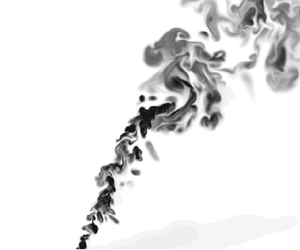Article contents
Under pressure: turbulent plumes in a uniform crossflow
Published online by Cambridge University Press: 15 December 2021
Abstract

Direct numerical simulation is used to investigate the integral behaviour of buoyant plumes subjected to a uniform crossflow that are infinitely lazy at the source. Neither a plume trajectory defined by the centre of mass of the plume  $z_c$ nor a trajectory defined by the central streamline
$z_c$ nor a trajectory defined by the central streamline  $z_{U}$ is aligned with the average streamlines inside the plume. Both
$z_{U}$ is aligned with the average streamlines inside the plume. Both  $z_c$ and
$z_c$ and  $z_{U}$ are shown to correlate with field lines of the total buoyancy flux, which implies that a model for the vertical turbulent buoyancy flux is required to faithfully predict the plume angle. A study of the volume conservation equation shows that entrainment due to incorporation of ambient fluid with non-zero velocity due to the increase in the surface area (the Leibniz term) is the dominant entrainment mechanism in strong crossflows. The data indicate that pressure differences between the top and bottom of the plume play a leading role in the evolution of the horizontal and vertical momentum balances and are crucial for appropriately modelling plume rise. By direct parameterisation of the vertical buoyancy flux, the entrainment and the pressure, an integral plume model is developed which is in good agreement with the simulations for sufficiently strong crossflow. A perturbation expansion shows that the current model is an intermediate-range model valid for downstream distances up to
$z_{U}$ are shown to correlate with field lines of the total buoyancy flux, which implies that a model for the vertical turbulent buoyancy flux is required to faithfully predict the plume angle. A study of the volume conservation equation shows that entrainment due to incorporation of ambient fluid with non-zero velocity due to the increase in the surface area (the Leibniz term) is the dominant entrainment mechanism in strong crossflows. The data indicate that pressure differences between the top and bottom of the plume play a leading role in the evolution of the horizontal and vertical momentum balances and are crucial for appropriately modelling plume rise. By direct parameterisation of the vertical buoyancy flux, the entrainment and the pressure, an integral plume model is developed which is in good agreement with the simulations for sufficiently strong crossflow. A perturbation expansion shows that the current model is an intermediate-range model valid for downstream distances up to  $100\ell _b$–
$100\ell _b$– $1000 \ell _b$, where
$1000 \ell _b$, where  $\ell _b$ is the buoyancy length scale based on the flow speed and plume buoyancy flux.
$\ell _b$ is the buoyancy length scale based on the flow speed and plume buoyancy flux.
JFM classification
- Type
- JFM Papers
- Information
- Copyright
- © The Author(s), 2021. Published by Cambridge University Press
References
REFERENCES
- 7
- Cited by





